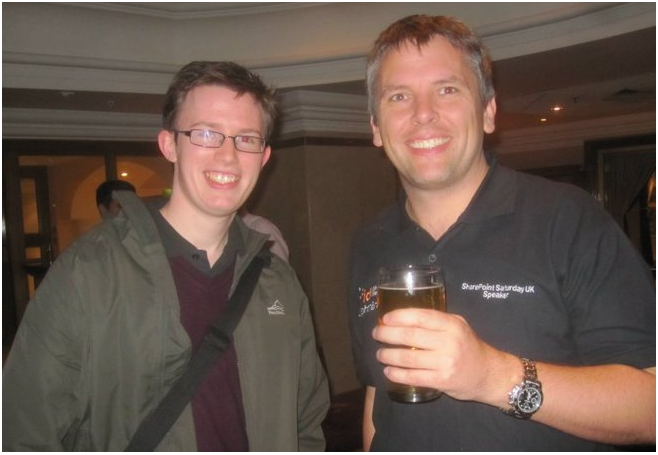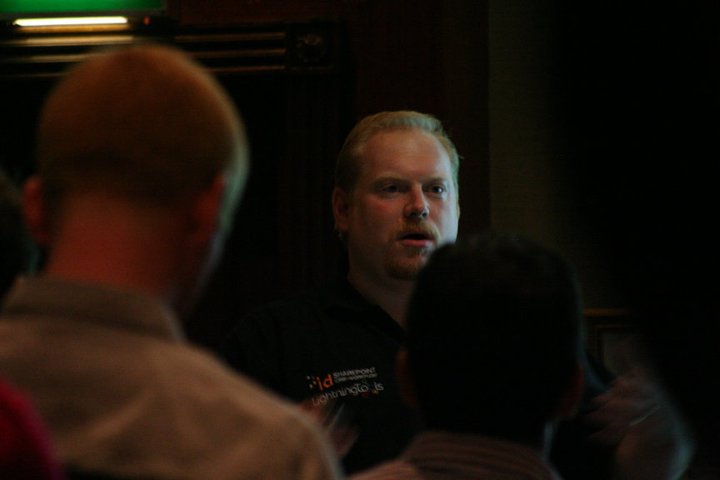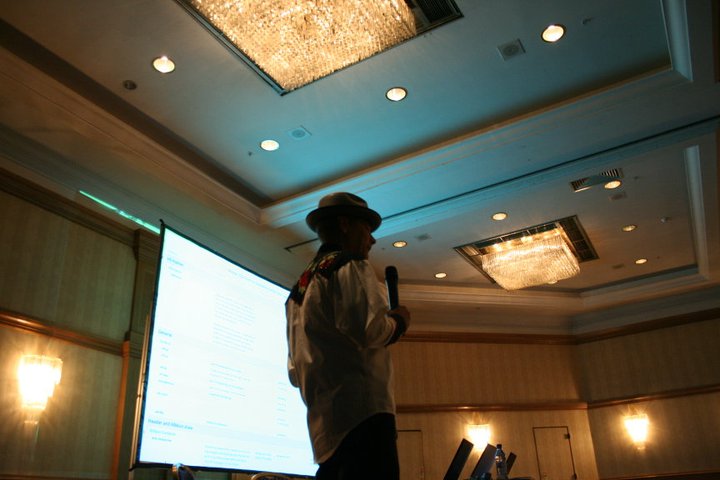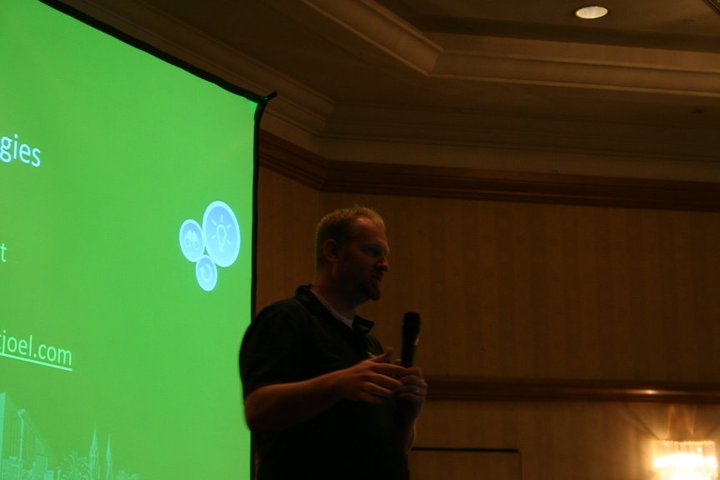After a rather busy weekend at Birmingham (SUGUK) and Nottingham (to visit an old friend), I figured it was about time I shared the notes that I made whilst at the UK’s first ever SharePoint Saturday. If you attended the event, you may have spotted me at the front row of most IT PRO sessions frantically scribbling notes and bashing out Twitter messages on my <popular multi-touch tablet>. If you didn’t manage to make it along to the event, I hope these notes will prove useful.
Before I begin, I want to express a huge thanks to , and (from ) for organising what could only be described as an awesome event. Whilst it certainly wasn’t the first SharePoint event I have attended (I’ve been along to numerous Notts SUGUK events, not to mention SPEVO earlier this year), the community spirit here was fantastic with quite literally everyone I spoke to showing a genuine interest in what everyone else was doing with SharePoint. The fact that the event took place on a Saturday – and was a huge success – just goes to show how big the product has become in the UK. I met too many people to shout out here, but a special mention goes out to (for driving me around Birmingham), (cheers for the #sharecurry!) and who made the effort to fly over from South Africa. Thanks also to the many speakers at the event – those that I saw were exceptionally knowledgeable and certainly held my attention – I can only hope that one day I will reach the dizzying height of speaking at a SPS event.
Thanks also to who took most of the photos below (I hope he doesn’t mind me putting them here :-]).

Yup – my Dad also thought I look geeky in this photo.
The notes that I took down are from an IT PRO point of view – although I do occasionally dabble in development (the odd Web part comes to mind) my focus is mainly around SharePoint infrastructure and architecture. Having said that, I did try to deviate from the beaten track a little by attending session on governance (which caused some heated debate within the audience to say the least!) and session on building communities (which was great – Mark really held my attention).
The relevant links for the sessions I attended are below (in order of attendance):
I also want to point you to the , which includes a great set of notes from on some of the session that I attended. Rather than duplicating content, I will try to cover those items that are not mentioned there.
Session 1: SharePoint in the cloud (Matt Groves)

Matt Groves puts us on cloud nine with a session on BPOS.
I personally think Matt’s presenting style is very engaging – he typically uses very few words and instead fills most slides with a relevant photo (you know the saying, right?). Aside from the information contained in the slides that are linked above, the following points grabbed my attention:
- SharePoint bridges the gap between software as a service (SaaS) and platform as a service (PaaS).
- (Microsoft’s business productivity cloud service) can be provisioned in around 15 minutes – that could potentially include SharePoint, OCS and email. Matt posed a rhetorical question to the audience: how many of you could provision those services in 15 minutes, which made the cloud offering sound very appealing.
- Matt mentioned the “” which allowed companies such as Facebook to grow on a massive scale (his example being FB scaling from 250 million users to 500 million in 8 months) through flexibility.
- There are two breeds of BPOS:
- BPOS-D (dedicated) – similar to on-premise with restrictions around customisations in the form of a very stringent (somewhat lengthy) custom code approval process.
- BPOS-S (standard) – multi-tenancy approach.
- Microsoft don’t currently have a UK based hosting capability – they have data centres in Ireland that fail over to Amsterdam. Matt mentioned that this currently prevents the UK government from utilising the BPOS cloud service for legal reasons.
- BPOS-S currently costs £6.70 per user per month. That means a company with 1000 users accessing SharePoint would pay £6,700 per month. Matt pointed out that although this sounds significant it may work out cheaper than maintaining and supporting an on-premise SharePoint infrastructure (bearing in mind the cost of specialised SharePoint infrastructure staff).
- BPOS-D is POA (priced on application – big surprise) and is available for a minimum of 5,000 users.
- For both scenarios, a minimum 12 month contract is required which could be seen as a major commitment for smaller firms.
- Matt mentioned that a significant business reason for choosing the cloud over an on-premise solution is predictable cost: it is very difficult to predict the cost of maintaining and supporting the latter.
- BPOS represents a shift from capital expenditure to operational expenditure.
- Microsoft have an office client support policy of “n-1” meaning that only the current and last version of office are supported (i.e. 2007 and 2010 at present).
- Security is probably the biggest concern (and barrier) around cloud computing.
The presentation closed with a discussion around off-shore storage of data and the security concerns around it. Matt mentioned that a certain US federal intelligence agency can access customer data without permission from the customer, suggesting that this applies regardless of where the data is located. This was challenged by some SPSUK delegates – in particular by from Microsoft who said he would follow up with a definitive answer from the MS legal team. At the time of writing I am still itching to hear the outcome of this given that data privacy in the cloud is such a hot topic.
Session 2: Build a SharePoint community (Mark Miller)

Mark Miller – Building Communities
Mark presented this session at the BPC earlier this year, and a probably does Mark’s (frankly brilliant) presentational style more justice than I ever could. In short, the session was exceptionally engaging due to the unique means by which Mark communicated his message. You will have to attend one of his sessions to understand where I’m coming from, but suffice to say he made a rather technical SharePoint geek more excited about the community aspect of SharePoint than I could have imagined. A combination of concise slides, relevant video content and Mark’s presence made this session stand out from the crowd.
One item of note is that Mark mentioned that will be heading up an IT PRO focussed area on the . That’s pretty exciting news and means EUSP is branching out to the more technical areas of SharePoint – hopefully that means more frequent, centralised IT PRO goodness :-).
Mark also made a point of telling us that “he didn’t speak Klingon” – meaning that he realised a while back that his focus should be helping end users rather than acquiring deep technical knowledge. I recommend checking out Mark’s EUSP article entitled
Session 3: MOSS 2007 to SharePoint 2010 Upgrade best practises (Joel Oleson)

Yup, SPSUK delegates got to meet Joel Oleson!
This was a pretty exciting session for me given that I had never met Joel before (is there a self respecting SharePoint geek that doesn’t want to meet SharePoint Joel?). Joel lived up to his reputation and was able to answer any and all questions fired at him around SharePoint 2010 upgrade and migration. Here are my notes:
- Most failed SharePoint upgrades are due to one or more steps in the upgrade cycle being skipped (those steps being Learn > Prepare > Test > Implement > Validate).
- Implementation is probably the smallest part of the upgrade cycle.
- Joel recommends the MOSS SP2 October CU and later prior to upgrading.
- Joel warned that an in-place upgrade will start – and fail – if SQL server doesn’t have the correct service packs and CUs.
- Virtualisation allows roll-backs via snapshots but careful planning is required around ensuring SharePoint servers stay synchronised (i.e. to avoid orphaned sites etc).
- The PreUpgradeCheck (STSADM) and Test-SPContentDatabase (PowerShell) commands should both be used to ensure a successful upgrade. The PowerShell command can be used by restoring a copy of the MOSS database into a test environment – even prior to an in-place upgrade.
- Missing features can be deactivated but usage should be checked prior to doing this.
- In-place upgrades are always serial, whereas the DB-attach method facilitates concurrent database upgrades using multiple PowerShell sessions.
- Upgrading a MOSS SSP to SharePoint 2010 is complex. Joel mentioned that one way of mitigating this is to perform an in-place upgrade of the SSP DB only in a test environment – this hybrid approach is also .
Session 4: SharePoint business governance and evangelism (Veronique Palmer)
I spoke to Veronique on Twitter a few days before SPSUK and I promised to go along to her session as I was interested to learn what governance was all about in the context of SharePoint. The session was packed out and several people had to stand around the edge of the conference room. I guess the other delegates were as keen as me to learn if there was an answer to the delicate balancing act of governance versus usability.
Veronique opened by saying “Howzit” – which apparently means “hello and how are you” over in South Africa – which I took to mean that they are pretty friendly (if a little sparing in their use of the English language) over there. Here are my notes from the session:
- Failure to communicate around a SharePoint project generally = a failed project (“game over” in Veronique’s words ).
- Veronique advised that the business must communicate changes around SharePoint, NOT IT to increase chances of acceptance.
- SharePoint governance generally falls into two distinct categories: IT and Business.
- Long term, the business must own SharePoint in order for it to succeed. Project sponsors should preferably have significant influence within the business.
- Veronique explained that governance plans must be comprehensive and illustrated this with an example: Microsoft held63 meetings to finalise their plan.
- Governance plans need to be aligned with the company vision.
- Acceptable usage policies must be implemented in the same manner as those in place for other services such as email and the Internet.
- Escalation procedures rely on effective communication. At this point I asked about how to help ensure emails were read – delegates advised me to ensure that both the subject and first line of each email were concise and to the point.
- A governance policy must include plans around dormancy (archiving) – again, communication was emphasised as a prerequisite for archiving.
- Veronique suggested that a separate help desk be implemented for SharePoint which appeared to stimulate some discussion amongst delegates. Her justification for this was that SharePoint requires specialist knowledge and requires a different support model when compared to other applications.
- Veronique made reference to both a published by Microsoft and governance – suggesting that she had experienced varying degrees of success with these sources.
- Power User training should be staggered to increase the chances of information sinking in.
- Basic (novice) training should not be forgotten to increase chances of user adoption.
Session 5: Virtualisation of SharePoint farm architecture (Michael Noel)
Michael opened his session by informing us that he co-authored the second SharePoint book ever to hit the shelves, which was a pretty sure fire way of grabbing my attention given the implied level of experience. Looking around the Internet for “Michael Noel” this evening made me realise just how well-known Michael is – I feel very fortunate to have been in the presence of another “internationally recognized technology expert”, particularly given that SPSUK is a free event.
- The two primary reasons to virtualise are to reduce costs through consolidation and add additional flexibility.
- Michael provided a great example where virtualisation adds flexibility: recent revelations around the in SharePoint 2010 mean that a required service account must run with local and farm administrator privileges on the server hosting it. This is contrary to Microsoft’s best practise recommendation to implement a least-privilege security model. Michael explained that he has utilised virtualisation to rapidly provision a virtual, isolated box to mitigate the security risk the UPS might otherwise have created here.
- Ideally, a 1:1 ratio of physical to virtual cores should be implemented for performance reasons.
- Recommendations were provided around RAM requirements – in the case of a SharePoint DB server Michael recommended no less than 16GB.
- Michael remarked that pre-grown databases were an absolute must for performance reasons (see my blog onSharePoint 2010 SQL DB autogrowth).
- Load balancing was recommended across physical hosts for redundancy purposes.
- SQL mirroring across virtual database servers is now supported (see ).
- Delegates were reminded that the tempdb is used constantly (for every SharePoint transaction) and that it is therefore critical that this database be looked after.
- Due to the fact that the tempdb is recreated every time SQL server is restarted, the database should be set to a fixed size that should be calculated based on the size of your largest content database.
- The myth that the tempdb should be split based on virtual cores is just that – it’s an old wives tale. Michael suggested that the split should be done based on the number of physical cores and stated that this was probably only relevant for large SharePoint farms.
- SQL Server 2008 R2 was strongly recommend over RTM, and can deliver up to 4 times the performance of its predecessor.
Overall, SPSUK was well worth the journey and I would strongly recommend it to anyone who has anything to do with SharePoint.
Please send me a or leave a comment if you have any queries or feedback!